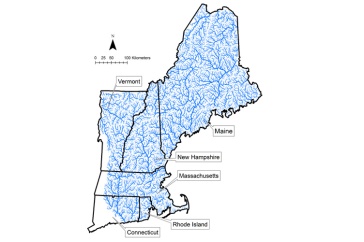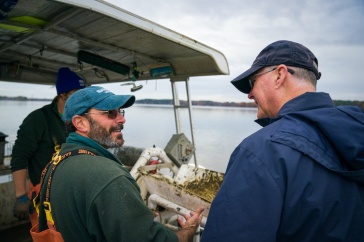
Great Bay Estuary (pictured) and its tributaries have long been – and will continue being –?a research focus of the NH Water Resources Research Center.


The New Hampshire Water Resources Research Center (NH WRRC) at the University of New Hampshire (UNH) is a cornerstone of supporting place-based environmental research and education in the Granite State, helping move forward knowledge and management strategies for pressing water issues—from the health of the Lamprey River to the impacts of suburbanization and climate change on regional watersheds. Now, under the new leadership of Adam Wymore, an associate professor in the UNH College of Life Sciences and Agriculture (COLSA), the NH WRRC is poised to continue and expand its legacy of innovation, advancing the monitoring and management of one of New Hampshire’s most important natural resources.
Wymore, who has worked as an assistant director of the NH WRRC since 2020 and serves as a researcher with the New Hampshire Agricultural Experiment Station, began his new appointment as director of the NH WRRC on Sept. 1, taking over for UNH professor emeritus Bill McDowell, who served as director starting in 2000 and retired from UNH in 2023.

“The WRRC serves as an important driver of water resources research for the state of New Hampshire,” said Wymore. “With growing demand on our water resources and the uncertainty of climate change, efforts to protect and conserve our freshwater resources is critical now more than ever.”
Research that the NH WRRC supports directly informs the management and protection of New Hampshire's vital water resources, which are essential not only for the state’s environmental health but also for its economy, public safety and quality of life. And as severe weather events, including droughts and floods, and the demands on water supplies increase, safeguarding these resources is critical for supporting industries like tourism and recreation, maintaining safe drinking water and ensuring the resilience of communities across the state.
A Legacy of Collaboration and Scientific Excellence
The NH WRRC was established in the late 1950s by UNH professor Gordon Byers. The center was later incorporated into the federal Water Resources Research Act Program, founded in 1964 and amended in 1984. The WRRA program is a federal-state partnership administered by the U.S. Geological Survey (USGS). In March of 2024, the WRRA commended the NH WRRC for its work over the previous five years (2016–2020), particularly in quantifying nutrient inputs to Great Bay and Little Bay and harmful algal bloom occurrences across the state. The center was also recognized for its publication of 43 journal articles contributing to water resource science and its strong support of student research.

associate director
McDowell notes that “The success of the NH WRRC is built on a long history of meeting water resource needs throughout the state in partnership with ecologists, engineers, hydrologists, economists, and other specialists at UNH, Keene State College, Plymouth State University and Dartmouth College. This broad base of research engagement, and strong collaboration with state and federal partners, will be central to meeting the challenges of the coming decades as well.”
Over the years, the NH WRRC has been instrumental in creating opportunities for scientists to address emerging and long-standing challenges that affect the quality and access to New Hampshire’s waters, including the effects of suburbanization on the Lamprey River watershed. The Lamprey River, with its mix of forests, agricultural lands and rapidly developing suburban areas, offers a unique setting to study these impacts and the process of suburbanization, said Wymore.
“By collecting long-term data on water chemistry and hydrology, we can track how land-use changes and climate shifts are influencing nutrient levels and water quality,” noted Wymore. “This research is crucial for informing management practices that protect not only the Lamprey River but also the broader network of water bodies that feed into New Hampshire's Great Bay.”
The Water Resources Research Act Program
The Water Resources Research Act (WRRA) Program is a federal-state partnership established under the Water Resources Research Act of 1964, with administration delegated to the U.S. Geological Survey (USGS) in 1984. The program’s primary goals are to support research that addresses state and regional water issues, facilitate technology transfer, and provide training opportunities for future water scientists and engineers.
The WRRA Program operates through a network of 54 Water Resources Research Institutes, with one in each state, as well as in U.S. territories. These institutes, typically housed at land-grant universities, serve as hubs for water research and education, focusing on a wide range of challenges, including water quality, water scarcity, and the impacts of climate change on water resources.
A key component of the WRRA program is its competitive grant funding, which supports research addressing critical water issues at both state and regional levels, fostering collaboration between academic institutions, government agencies, and local stakeholders. The program also emphasizes the dissemination of research findings to ensure that new knowledge is applied in practical water management and policymaking.
By linking federal resources with state needs, the WRRA Program plays a crucial role in ensuring sustainable water management across the United States, helping to safeguard this vital resource for future generations.
Research from the NH WRRC has also focused on better understanding how the interplay of climate, soil and watershed characteristics influence carbon, nitrogen and salt levels in streams and rivers—a critically complex relationship that is core to developing effective strategies to prevent nutrient pollution in New Hampshire's freshwater ecosystems. As rapid climate change in the Northeast continues, the center’s work will be critical to helping inform science-based management and policies that will help protect and sustain the state’s fisheries, food webs and recreational water bodies.
The impact of NH WRRC’s work is heightened through leveraging interdisciplinary partnerships and meeting its education and outreach missions. Recently, Catherine Ashcraft, an associate professor in COLSA's natural resources and the environment department, and Ph.D. student Michal Zahorik led an NH WRRC-supported research project examining how strategic land conservation efforts can help improve flood risk management. Jeffrey Miller, a research assistant professor in COLSA’s molecular, cellular and biomedical department, led research that measured the contribution of picocyanobacteria—one of the smallest types of cyanobacteria—to harmful blooms in New Hampshire lakes.
Expanding Partnerships and Supporting Future Water Resource Leaders
Under Wymore’s leadership, the NH WRRC will continue its deeply rooted tradition of partnerships and outreach. The center has built strong collaborations with the NH Agricultural Experiment Station, UNH Cooperative Extension and with regional watershed organizations like the Lamprey River Advisory Committee and the Green Mountain Conservation Group. These relationships not only enable stronger and more impactful research but ensure that the science reaches those who apply that knowledge through technical support to federal and state agencies, including the New Hampshire Department of Environmental Services and the U.S. Geological Survey and direct engagement with local communities.
“The WRRC has a rich history of supporting the development of the next generation of researchers and managers focused on freshwater resources, watersheds and water quality,” Wymore said. “There is a huge cohort of early-career researchers who are really invested in conserving our natural resources and ecosystems, and the WRRC is proud to support these younger scientists by providing funds and platforms for research experiences throughout the state.”
As the NH WRRC moves forward under Wymore’s leadership, the center will continue its tradition of excellence in water research. Wymore is committed to addressing the evolving challenges posed by climate change and increasing development pressures, ensuring that New Hampshire's water resources remain protected and sustainably managed for future generations.
“Climate change poses real and significant threats to our state and national freshwater resources,” he stated. “And understanding the role of shifting seasonality and increased climate variability, including more frequent floods and droughts, will be a focal point of the New Hampshire Water Resources Research Center in the coming years.”
Wymore added, “And I’m excited to continue working with WRRC staff, including Associate Director Michelle Shattuck, who has an extensive history of working with the WRRC and a deep knowledge of issues surrounding water resources in the Granite State.”
To stay updated on the NH WRRC’s work and upcoming events, visit their website, check out the latest NH WRRC news?and explore their recent publications and symposiums.
-
Written By:
Nicholas Gosling '06 | COLSA/NH Agricultural Experiment Station | nicholas.gosling@unh.edu



















































